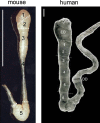New insights into epididymal biology and function
- PMID: 19136456
- PMCID: PMC2639084
- DOI: 10.1093/humupd/dmn055
New insights into epididymal biology and function
Abstract
Background: The epididymis performs an important role in the maturation of spermatozoa including their acquisition of progressive motility and fertilizing ability. However, the molecular mechanisms that govern these maturational events are still poorly defined. This review focuses on recent progress in our understanding of epididymal function including its development, role of the luminal microenvironment in sperm maturation, regulation and novel mechanisms the epididymis utilizes to carry out some of its functions.
Methods: A systematic search of Pubmed was carried out using the search term 'epididymis'. Articles that were published in the English language until the end of August 2008 and that focused on the specific topics described above were included. Additional papers cited in the primary reference were also included.
Results: While the majority of these findings were the result of studies in animal models, recent studies in the human epididymis are also presented including gene profiling studies to examine regionalized expression in normal epididymides as well as in those from vasectomized patients.
Conclusions: Significant progress has been made in our understanding of epididymal function providing new insights that ultimately could improve human health. The data also indicate that the human epididymis plays an important role in sperm maturation but has unique properties compared with animal models.
Figures



References
-
- Aitken RJ, Nixon B, Lin M, Koppers AJ, Lee YH, Baker MA. Proteomic changes in mammalian spermatozoa during epididymal maturation. Asian J Androl. 2007;9:554–564. - PubMed
-
- Amann RP, Howards SS. Daily spermatozoal production and epididymal spermatozoal reserves of the human male. J Urol. 1980;124:211–215. - PubMed
-
- Asquith KL, Harman AJ, McLaughlin EA, Nixon B, Aitken RJ. Localization and significance of molecular chaperones, heat shock protein 1, and tumor rejection antigen gp96 in the male reproductive tract and during capacitation and acrosome reaction. Biol Reprod. 2005;72:328–337. - PubMed
-
- Aumuller G, Wilhelm B, Seitz J. Apocrine secretion—fact or artifact? Ann Anat. 1999;181:437–446. - PubMed
-
- Avram C, Yeung CH, Nieschlag E, Cooper TG. Regulation of the initial segment of the murine epididymis by dihydrotestosterone and testicular exocrine secretions studied by expression of specific proteins and gene expression. Cell Tissue Res. 2004;317:13–22. - PubMed

